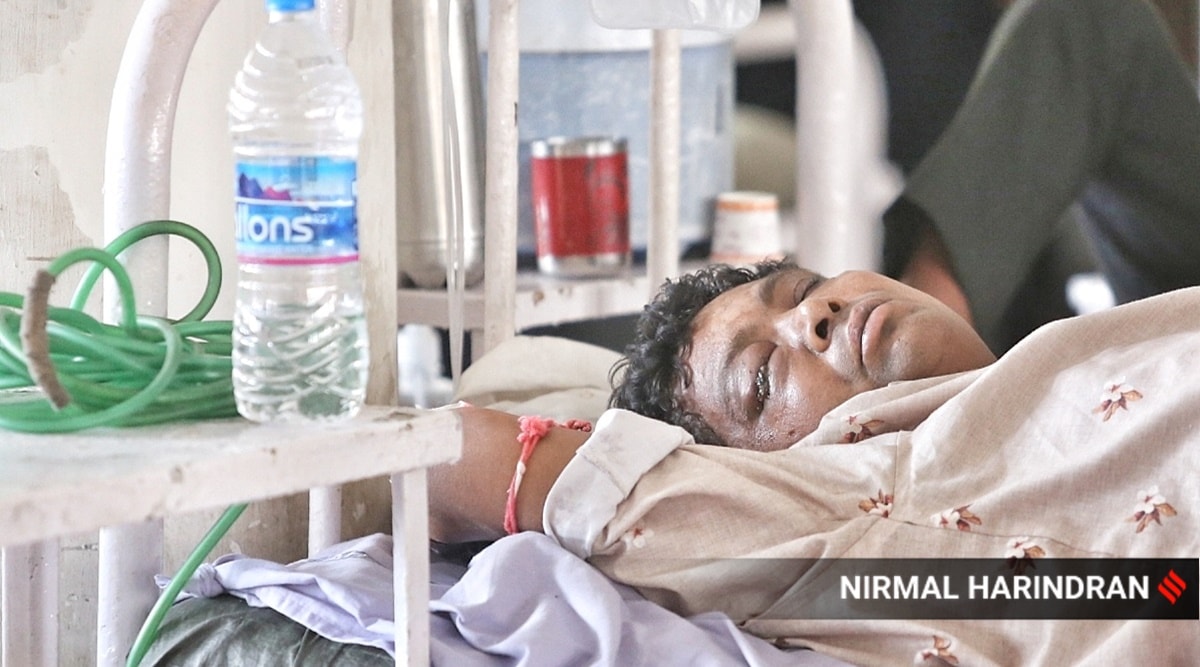 Pulmonary mucormycosis is common among immunocompromised patients whose immune systems have lowered ability to fight infections and diseases. (Source : Express File)
Pulmonary mucormycosis is common among immunocompromised patients whose immune systems have lowered ability to fight infections and diseases. (Source : Express File) Mucormycosis, known as ‘Black Fungus’, is a fungal infection that mainly affects people who are on medication for other health problems that reduces their ability to fight environmental pathogens. Sinuses or lungs of such individuals get affected after fungal spores are inhaled from the air.
“Certain sets of population and situations make people more vulnerable to this infection which includes people with uncontrolled diabetes, immunosuppression by steroids, prolonged ICU stay, comorbidities after transplant or malignancies and voriconazole therapy,” said Dr Minal Vohra, Consultant Endocrinologist, BeatO.
She added that “Mucormycosis can be triggered in humans by the use of steroids, a life-saving treatment which is for moderate-to-serious COVID cases. While steroids reduce inflammation in the lungs, it also reduces the overall immune response and significantly increases the sugar levels in both diabetics and non-diabetic Covid-19 patients. This is especially challenging for people with hyperglycemia who are unable to manage sugar levels during Covid.”
Presentation of two types of mucormycosis have been commonly observed with Covid-19 patients, whether active, recovering or post-discharge. This includes Rhino-Orbito-Cerebral Mucormycosis (ROCM) and Pulmonary mucormycosis.
“The timeline of presentation of symptoms depends on the glycemic status, comorbidities and steroid usage of the patient. The progression of the infection is quite rapid, hence by the time a patient realizes their symptoms – the disease has already invaded the patient’s organs. Suspicion of mucormycosis must remain high in the vulnerable population,” she told indianexpress.com.
Rhino-Orbito-Cerebral Mucormycosis (ROCM)
In simple words, ROCM means the mucormycosis in which the fungus affects the nose, eyes and brain. This disease originates from the nose and rapidly spreads along the sinus passage to infect the orbit (bone cavity which surrounds the eye) and brain. Hence, the infection can be classified into three stages.
In the initial stage, the patient will experience either nasal blockage or congestion, nasal discharge (bloody or brown/ black) and localized pain inside the nose. The patient will then start to develop facial pain, numbness or even swelling of the face.
As the infection progresses and reaches the orbit, the patient begins to experience headache and orbital pain, which means pain in or behind the eye. Blurred or double vision with pain, vision loss in one or both eyes, partial or complete blindness can also be witnessed.
Toothache, loosening of teeth located in the upper jaw and dysfunction in jaw movement. Paresthesia, or abnormal sensation in the skin such as tingling, chilling, burning or numbness can be experienced. Patients also exhibit fever, skin lesions and a black eschar on the skin near the eyes or nose.
Unstable gait, altered consciousness and seizures indicate the spreading of the fungus to the brain.
Pulmonary mucormycosis
Primarily affecting the lungs and respiratory system, pulmonary mucormycosis is common among immunocompromised patients whose immune systems have lowered ability to fight infections and diseases.
Patients with pulmonary mucormycosis exhibit symptoms including fever, cough, shortness of breath and chest pain. Some individuals go through hemoptysis as well, which means coughing up blood. Respiratory symptoms worsen as the infection spreads and patients may observe pleural effusion as well, which means fluid collection in the outer covering of lungs.
How to diagnose mucormycosis
If a patient exhibits symptoms of mucormycosis, it must be treated as a medical emergency and clinical diagnosis must be carried out immediately. Suspected patients should undergo appropriate radio-imaging study.
*MRI PNS (para nasal sinuses) with brain contrast study for RCOM
*Plain CT Thorax for pulmonary mucormycosis
Treatment of Covid-associated Mucormycosis
Mucormycosis is often caused due to uncontrolled diabetes or misuse of steroids in immunocompromised patients. Hence, the first step is to control diabetes, maintain judicious use of steroids (time, dose and duration) and discontinue other immunomodulation drugs. The need to control hyperglycemia (High sugar levels), especially after discharge following Covid-19 treatment is extremely crucial for both diabetics and non-diabetics.
“Mucormycosis can be treated with a proper antifungal treatment, if the condition is detected early. In most cases, surgical debridement may be eventually required to remove necrotic material on the skin. A team approach is required which should include infectious disease specialist, microbiologist, histopathologist, intensivist, neurologist, ent specialist, ophthalmologist, dentist, surgeons and radiologists,” she said.
- The Indian Express website has been rated GREEN for its credibility and trustworthiness by Newsguard, a global service that rates news sources for their journalistic standards.

